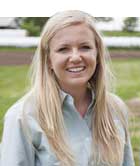
In the southern Great Plains, forage is grown in the spring and fall, corresponding to the seasonal rainfall patterns. As a result, there are typically forage shortages in the winter and summer months.
“We have learned to overcome some of the wintertime forage shortfall by shifting part of the late summer and early fall forage growth to winter by creating stockpile forage,” says James Rogers, forage researcher at The Samuel Roberts Noble Foundation. “The same process can be used to help overcome the summer forage slump.”
In the Foundation’s newsletter, Ag News and Views, Rogers notes that it can be difficult to figure out what to do with all the forage produced during the spring flush. However, if forage production and demand are balanced, managing forage year-round will be easier. Rogers suggests striving to find this balance so an appropriate long-term carrying capacity for an operation may be developed.
The majority of warm-season perennial forage growth will occur by July 1. In a grazing rotation, it may be hard to rotate fast enough to top all the pastures before they start getting ahead.
However, the pastures can be grazed after July 1 as summer stockpile. At this point in the year, cow nutritional demand is declining so greater forage maturity will not be a problem. Forage growth and grazing rotations will also be slowing.
If summer stockpile is introduced forage such as bermudagrass, allowing cattle to graze the pastures longer will remove the excess growth from summer. Follow up with nitrogen (N) fertilizer to stimulate fall growth for winter stockpile grazing. If summer stockpile is native grass, allow it time to rest prior to frost so carbohydrate reserves can replenish for spring growth.
“Another method to help adjust the flow of introduced forage is to manipulate application of nitrogen fertilizer,” Rogers says.
However, to take advantage of this, rainfall needs to be in your favor. Prior to applying any fertilizer, soil test to be sure other nutrients will not limit the nitrogen response. Assuming other nutrients are not limiting, splitting nitrogen applications can help to more evenly distribute forage production and quality.
For example, if you typically apply 100 pounds of N per acre in May to bermudagrass pastures, consider applying 50 pounds of N per acre in May and another 50 pounds in June to shift production to the summer slump in July and August. Another option is to apply 50 pounds of N per acre in May for spring and early summer growth, followed by 50 pounds of N per acre in August for fall stockpile.

Sydney Sleep was the 2016 Hay & Forage Grower summer editorial intern and is a junior at South Dakota University.

